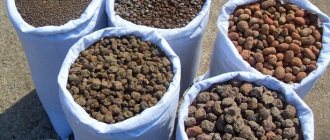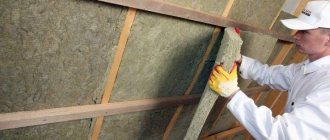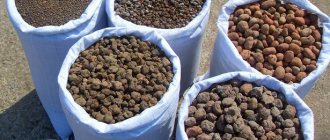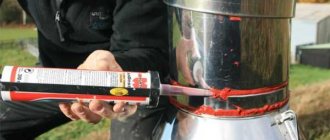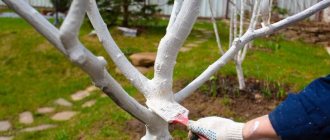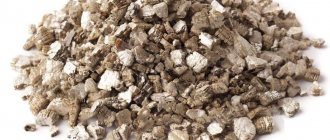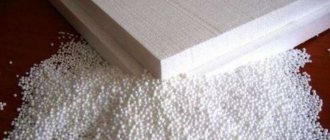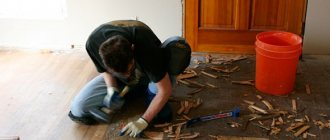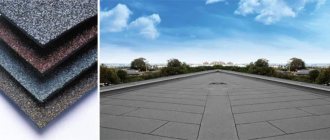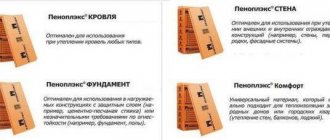Cancellation
To make a bonding mass for masonry or plaster, you need to use slaked lime and sand. Proper extinction is the most important condition. Otherwise, a high-quality solution cannot be prepared. For this procedure, a special container is used, into which water is gradually poured over the lime in small portions. If the lime is not applied correctly, it will negatively affect the screed.
The time required for extinguishing is often indicated directly on the packaging. The lime is slaked from 7 minutes to half an hour (the time until the thermal reaction subsides). Complete extinguishing - 24-36 hours. For this procedure you need a respirator, gloves and thick clothing: quicklime is a caustic substance. A special device is made for extinguishing, it looks like this:
Creative box: 1 - valve, 2 - sieve, 3 - creative pit, 4 - rake
On the left in the picture is the water supply tap. But in artisanal conditions, they simply use a box or metal container immersed in a hole about 1 meter deep. The operating procedure is simple:
- Pour the building material into the container.
- Fill with cold water in a proportion of 1 liter per 1 kg (2 liters per 1 kg for whitewashing walls and ceilings).
- Stir the resulting mixture each time the steam decreases.
Important: do not stand over the container after pouring water: the released vapors are hazardous to health.
At some point, the chemical reaction will stop completely. After this, the lime is passed through a sieve (see diagram above). Now it is kept for at least 2 weeks for masonry and 30 days or more for plaster.
Photo: chemical reaction when slaking lime. The process is carried out on a summer cottage.
paints and varnishes
77 votes
+
Vote for!
—
Vote against!
Water emulsion is good, but fluff is cheaper and better for disinfection . This is due to the fact that lime, in addition to its coloring ability, has an antiseptic property, and therefore prevents the formation of fungus and mold on any surfaces. This article will discuss the preparation of lime.
Lime composition
- Lime is the name given to materials after firing and special technology for processing natural materials such as chalk, shell rock, limestone and other carbonate rocks. Thermally treated in furnaces of various types at +1000 - 1200 degrees, blocks of rock are transformed into pieces of various shapes.
- For further use, they undergo special processing without any chemical components or catalysts. Therefore, the result is a 100% natural material, which may contain a small amount of mineral additives and clay impurities.
- Lime is most often used in construction. And not only. Special grades of lime are widely used in the ferrous metallurgy, food, pulp and paper, leather, chemical, textile and sugar industries. Lime is also used by agricultural workers and environmentalists to neutralize flue gases or water runoff.
Popularity of lime
History has not preserved the name of who was the first to think of using the unique capabilities of lime. It is quite possible that this was one of the first finishing materials for decorating the homes of our ancestors. Obtaining patents and copyrights for innovations appeared already in modern history. Now he would be among the richest oligarchs in the world.
Indeed, according to experts, approximately 300 million tons of lime are produced annually in the world. Of this, 120 million tons are sold on the market. Russia is among the leading producers of this finishing material. About 10 million tons of lime are produced annually in the country. Of these, 4 million tons are for construction.
- Lime is used the longest and most often for whitewashing of all decorative materials. Its use does not require special skills or physical effort. It is reliable and not too burdensome for the family wallet.
- Whitewashing wooden structures or house walls with lime solution is a means that has been used and tested for centuries. It was made not only for decorative purposes, but also to prevent wood rotting and fire protection.
- Today in megacities, almost no one covers the walls of rooms with lime. However, in the rural outback they still prefer to use it to cover hidden beams, invisible rafters or internal purlins.
Varieties of lime
Silicates give lime its hydraulic properties. Depending on the degree of their content, lime is considered air or hydraulic. Hydraulic lime has the ability to enhance the hardening process and maintain the strength of solutions both in air and in an aquatic environment. Depending on the content of clinker minerals, it can be weakly hydraulic or strongly hydraulic.
Air lime is intended to ensure hardening of mortars used in construction and maintain their strength at normal humidity levels.
Based on the level of oxide content, they are distinguished:
- calcium;
- magnesia;
- dolomite.
According to the type of processing, lime is:
- lumpy, so-called boiling water;
- ground in the form of a powder obtained by grinding burnt lumps;
- fluff, which is slaked material obtained after extinguishing the lumps with water;
- lime paste - a product for slaking lump raw materials;
- lime milk - white suspension.
In addition, lime is divided into:
- quickly extinguishing within no more than 8 minutes;
- medium extinguishing - no more than 25 minutes;
- slowly extinguishing for at least 25 minutes.
Lime in powder form is available with or without additives. The most famous type is quicklime. It is widely used in the production of concrete, construction, finishing, binding and antiseptic solutions. With its help, artificial stone is produced.
When using different technological parameters for burning rocks, lumps of lime are obtained with different degrees of strength:
- hard fired;
- softly burnt;
- intermediate option.
As a material for construction work, softly burnt lime is most often used, which has:
- smallest grain size;
- lower density;
- minimum extinction time.
During the extinguishing process, heat is released. If you do not follow safety precautions, there is a risk of severe burns.
From the lime quality certificate of conformity you can learn about the type and condition of the lime, and the percentage of impurities. This document is issued only to organizations that comply with GOST when manufacturing the material.
What is lime made from?
The type and grade of lime determines the main scope of its use.
- Lime for construction work is made from rocks containing a high percentage of calcium and magnesium. It is used as a plasticizer in concrete mixtures and binding solutions. This brand is sold with lime dough or in lumps and fluff.
- To produce hydraulic lime by firing, limestones containing 6-20% clay impurities are used. This grade is used for the production of low-grade concrete because it has low ductility, in contrast to a high level of strength. Hydraulic lime is often used in the construction of structures that will be used in conditions of high humidity.
- Lump lime is used as a semi-finished product for the preparation of powders or solutions. It is stored in closed warehouses to protect it from moisture. It is most often sold for the preparation of whitewash solutions.
- Garden lime is used to enrich acidic soil with calcium. Without enough of it, plants grow and develop poorly. Slaked and quicklime are added to the soil in rainy spring or autumn weather. Precipitation promotes better dissolution of limestone.
- The porous white mass of soda lime is caustic soda mixed with slaked lime. Another area of application is the production of gas masks and pressure chambers, equipment for divers.
- Bleach contains free chlorine and calcium hydroxide. It has powerful disinfectant and whitening properties.
Properties of lime
- Low cost . In the rating of materials, lime in lumps is rated quite highly. Finding a material for finishing work with the same combination of price and quality is almost impossible.
- Disinfection . Bacteria that fall on the film formed by lime die.
- Moisture resistance.
- No unpleasant odor.
- Versatility . Possibility of use both on old whitewash and on new surfaces.
- UV resistance.
- Friendly attitude towards dyes.
Two main disadvantages of lime:
- The risk of streaks, streaks, and bubbles if the percentage rules for preparing a solution for whitewash or concrete are not followed. A very liquid consistency will not paint the surface to the required saturation, and a thick whitewash solution, when drying, will turn into bubbles and crumble.
- Due to its caustic properties, extreme caution is required when working with lime..
Do-it-yourself lime
Lime for whitewashing is used on facades after plastering, surfaces of walls and ceilings in basements and rooms with high humidity or dry ones, kitchens, toilets. The lime composition is steadfastly indifferent to the influence of water and temperature changes. For example, ceilings are whitened with lime milk, and smooth walls after plastering are painted with lime-based paints.
- Lime is used for primers and water-based paints for finishing surfaces inside and outside, not only as a paint, but also as a binder. However, for tinting alkaline lime mixtures, only alkali-resistant pigments are used. For example, for 1 kg of lime no more than 100 g of soot or chromium oxide, mummy or umber is added. These dyes are diluted with water to a thick porridge. After 5 hours of exposure, stirring vigorously, add color to the fluff, which is diluted to the consistency of milk.
- It is more rational to buy dry lime. It lasts quite a long time. Preparation for use does not take much time.
- Before diluting lime, large lumps must be crushed and quenched. Depending on how the solution will be used, a fluff (powdered solution) or dough is prepared. To do this, you need to take different amounts of liquid.
- To prepare fluff for whitewashing a surface with an area of 2.5 squares, you need to take a sufficiently deep container that is sure to be rust-free. This is necessary because when slaking lime with water, the volume increases 2-3 times.
- Place 1 kg of lime lumps in a bowl. Pour 0.75 - 1 liter of cool water. Cover loosely with the lid to allow steam to escape. If you use little water to slak the lime, it can “burn out.” If there is too much water, the lumps of lime may “suffocate”.
- The procedure should be carried out with extreme caution, because the solution heats up to approximately 140-150 degrees. The boiling mixture hisses and splashes, so it is better to play it safe and wear safety glasses and gloves before extinguishing the lime.
- During the 8-30 minute boil, thoroughly stir the seething mass with a wooden stick.
- When the extinguishing process is completed, you need to close the container with a lid and put it in the cellar for 15-30 days. Only after such exposure does the material acquire the most effective, disinfecting and reliable properties.
- On the day of whitewashing, you need to dilute the fluff with water. Whitewashing walls or ceilings is done with lime milk, obtained by thoroughly mixing 3 parts of water with 1 part of freshly slaked lime. Add enough liquid so that on the stick with which the solution is stirred, perfectly white lime remains in the form of a dense and even film.
- To prepare lime dough, the algorithm will be the same. In addition to the amount of liquid, which will require significantly less.
Five tips from professionals for working with lime
- To increase the strength of the coating and prevent swelling of the plaster layer, 10-15% of paint with a latex base or wallpaper glue is added to the milk of lime.
- To ensure that the lime milk mortar adheres more tightly, green soap (1 tablespoon) is added to ½ bucket of whitewash mortar.
- To give the decorative whitewash additional durability, add drying oil (1/3 of a full tablespoon) and table salt (about 5 g) to this volume. Everything is thoroughly mixed and then filtered through a fine sieve to remove undissolved lumps and grains.
- A light bluish tint, which favorably shades the surface of the ceiling in daylight, can be obtained by adding blue (20 g).
- Painting with lime-based paints should be done on cold or damp days.
Lime consumption
- Whitewashing the surface of walls, ceilings or other building structures is considered the most inexpensive finish. Consumption depends on the chosen application technology and the smoothness of the surface. More whitewash is required when using a brush. Perfectly leveled walls will require less lime milk than painting brick surfaces. The approximate consumption per 1 m² of smooth walls is 0.5 liters of ready-made whitewash solution.
- Typically, professional craftsmen estimate whitewashing 1 m2 of walls in one layer at 50 rubles or more. The price depends on the need to remove dirt or paint, the structure of the surface, and the number of layers.
Lime consumption during whitewashing
In terms of cost, using lime is more profitable than painting walls with water-based paints or decorating with other materials. And in terms of quality characteristics and antiseptic properties, it surpasses many of them.
Fillers and binders
A plaster mixture of lime and sand is the most versatile material for interior decoration. In order for the mixture to become better, cement, clay or gypsum are added to its composition as binders.
- the cement-lime type is used in repair work both inside and outside buildings;
Photo: mixing lime in a bucket using a drill attachment
- mixture with clay - to strengthen stoves or walls of wooden houses;
- if you add gypsum to the composition, you get a lime-gypsum mortar - an excellent material for plaster;
- sand is the most common and integral component.
Fluffy lime preparation technology
Fluff is prepared by spraying lump quicklime with water and immersing the lump lime in water. In both cases, it is advisable to use airy calcium lump lime of the 1st and 2nd grades according to GOST 9179 - 77, containing a minimum amount of unslaked grains. Lump lime is usually delivered to the slaking site in bulk in a dump truck.
To prepare fluff, a platform is equipped by spraying lump lime with water (Fig. 1). To extinguish 5 - 6 tons of lump lime, a 3x5 m area is fenced off next to the construction site or on its territory and a high canopy of boards is built above it, covered with a layer of roofing material on top. On one side of the site under the canopy, a platform measuring 2x3 m is leveled and compacted. Next to it, outside the canopy, several metal or wooden barrels of 200 liters each are installed. To spray lime with water, prepare 4 - 5 watering cans, 15 liters each. If the construction site has a water supply pump or water supply system, a pipeline with a valve, a rubber hose and a sprinkler (shower) is laid to the site under the canopy.
The delivered lump lime is unloaded under a canopy. The barrels are filled with water. 1 m3 of quartz sand is delivered and stored. Make sure shovels and rakes are in good working order. Check the instruments for measuring the temperature of slaking lime. If there is a water supply, make sure that the valve is working properly and check the water pressure in the pipeline.
The fluff is prepared in the following sequence. Using a shovel, spread an even layer of lump lime 0.2 m thick over an area measuring 2x2.5 m onto the compacted earth, spray it evenly over the entire area with water from a watering can or using a hose with a sprinkler. In this case, the layer contains approximately 900 kg of lime, about 500 liters of water are consumed to extinguish it. A new layer of lime 0.2 m thick is thrown over the moistened layer and again evenly sprayed with the same amount of water. The operations of throwing a layer of lime and moistening it are repeated 5 - 7 times until the total height of the stack is 1.5 m. Approximately at half the height of the stack, a thermocouple connected to a millivoltmeter is placed in it.
Component proportions
The standard composition is a proportion of 1 to 4. The first number is lime, the second is sand. In the case of gypsum, the numbers change to 3 to 1, and if you add cement, then the proportions are 2 to 1.
To determine if the mixture is viscous enough, dip a spatula into it. If the liquid mass drains easily from it, it is necessary to add a plasticizer to the composition, because the viscosity is insufficient.
If the spatula has difficulty getting into the mixture, the solution needs to be thinned. Good viscosity is visible in the photo below. You will get excellent adhesion to the wall.
Photo: using a spatula
Login to the site
Hello, dear reader!With you is the author and presenter of the newsletter Andrey. Our website is https://www.homeidei.ru. If you have your own secrets, send your ideas and we will post them on the website and in the newsletter. Write
Capper. Confident sports betting.
Earning money from betting at bookmakers. Fixed matches in football. Fixed Matches / Fixed Matches at:
BetForWin.ru
And now issue # 191 Homemade lime production
In business ideas, I’ll tell you about an interesting business that my friend has been doing for several years now. After working in construction for 10 years and earning a lot of illnesses, he came to the conclusion that in order to live with dignity, he needed to open his own small business and he found a very interesting niche in the construction business, which he got into. He decided to produce ordinary lime at his dacha.
Who needs lime? Lime is a building material that is used to prepare binder building mixtures. This is, in fact, whitewash that is used to smear ceilings. This is what we will talk about the production and sale of ordinary lime. If you visit building materials stores, you will see that lime is sold in small bags of 250 grams, in our city one such bag costs from 20 rubles. And the production cost is negligible, no more than 5 rubles per 250 grams.
It is not difficult to calculate that the trade margin is huge. The business is simply super profitable. We pack the finished products in bags and take them to construction materials stores for sale, submit advertisements in newspapers about wholesale sales, construction companies will definitely respond. You will not be left without a sales market. Now about the most important thing about the technology for producing lime at home.
You need a small room, a shed on your summer cottage will do, preferably with heating in winter. So, go get some limestones. There are many of them along the railroad tracks, and there is a lot of limestone in abandoned quarries. Collect any; then, during the preparation process. The fact is that stones up to 2 centimeters in size are better suited for firing. But large limestone stones can easily split into pieces of any size.
Prepare coal - firewood is not suitable, the temperature in the oven should be above 800 degrees. Pour a layer of coal into the oven and let it get hot. . Now your limestones will go into action. Place them on top of the coal in an even layer, neither thick nor thin. Then cover the layer of limestone with another layer of coal.
It is better to do this in the evening, then by the morning the process will be completed, and you can safely begin removing the burnt limestones. Everything is done with tongs or a scoop. If the stones are white, then the lime was successful.
But that is not all. Lime must be slaked. Water is poured into the bucket, and then pieces of burnt lime are placed in the water one by one. The slaking time is about 8 minutes, after which a white solution will remain in the bucket, this is lime . The solution is taken out, filtered through cheesecloth, dried, and the lime is all ready.
Here is a small factory at home. Why not a home business? I already wrote about implementation methods at the very beginning of the article.
Author: Andrey Cosmos, source website https://www.womanbusiness.ru/idey161.htm
| Online store - 400 Technologies . Your life activity is a chain of practiced household and business technologies such as going to the store, choosing a TV channel, working, etc. The more perfect each of them is, the more effective the entire chain is. Of course, you can create everything yourself, but it’s more promising to use the experience of experienced people in solving complex problems. Check out the catalog of technologies, follow the link https://www.homemagazin.ru/shop.htm PS Gift of the site to every visitor FREE method - “How get an apartment for free in a few months” Haven’t you read this technique yet? It's real! Find out simple solutions to complex problems! |
And now interesting facts from the section “The Amazing is Nearby!” Issue No. 187.
1562. Training of anti-tank dogs in the Russian army continued until 1996.
1563. The tallest Olympic flame in history was lit at the top of the 318-meter Aspire Tower, a hyperboloid tower in the city of Doha.
1564. The commissioning of the Sakhalin tunnel, built by prisoners, was scheduled for 1955.
1565. Massive construction of castles in England is associated with a period of anarchy in the mid-12th century.
1566. Three arsenals have been preserved in Lviv: the City, the Royal and the Senyavsky arsenal.
1567. Managing the imperial post office in Central Europe, the Thurn-and-Taxis family rose to the ranks of the highest aristocracy and achieved the title of prince.
1568. Sazhi Umalatova was first elected as a deputy at the age of 18.
1569. Among the priestless Old Believers there were runners who did not have passports, rejected the oath, taxes, and in some cases even money.
1570. In 2007, at a Sotheby's auction, the feces of the Italian artist Piero Manzoni were sold for 124,000.
To be continued in the next newsletter.
Source: sites https://www.izobretenija.ru https://www.tehnoidei.com.ru
PS
We invite you to subscribe to our friends' newsletters.
In your e-mail you will receive news from the world of computers, technology, inventions, and computer jokes. There have never been such mailings on the Internet! Subscribe and you won't regret it!!! That's all for today! All the best!
Preparation of solutions
The sand that is to be mixed with slaked lime must first be sifted (quarry sand). If the sand mass is of river origin, it is washed. River quartz is considered the highest quality. But mountain or ravine sand is not valued because it contains a lot of clay. Marine is not used due to its high salt content.
You can also find ready-made slaked lime on sale. The contents of the package will look something like this:
Photo: dry lime
To make the simplest solution, sand is poured into the prepared lime in a proportion of 4 parts sand to 1 part slaked “dough”. In the next step, add water and mix the resulting mass thoroughly. Sand is also added afterwards to give the mass the necessary physical qualities. If the mixture has thickened after standing for several days, just add water to it.
Cement-lime mortar can be made in three stages:
- Dilute the “dough” with water until liquid and strain through a sieve.
- Mix cement with sand.
- Mix the components obtained in the two previous steps.
With gypsum, everything is different: first you need to mix it with water until it resembles the consistency of sour cream. Only after this can gypsum be added to the lime mortar, and then everything can be mixed thoroughly.
Composition and sequence of preparation of lime-clay mortar: first of all, the clay is mixed with a mass of lime, and only then the sand mass with water is added.
How to choose premises and employees
The plant should consist of the following sections: crushing, milling, storage and mixing of products, as well as a shaft furnace section and space for storing and packaging finished goods. By simple calculations we can conclude that the optimal area should be about 2000 square meters.
Renting such a premises will cost 250,000-350,000 rubles, depending on the location of the building. If you plan to produce approximately 50 tons of finished products per day, then you will need a crusher operator and two mechanics (elevator and conveyor). The sorting department needs to hire a screen mechanic and an assistant, as well as professionals to work with the elevator and conveyor.
The most people are needed in the firing department, since this is where the most work is done. You will need two mechanics for the elevator and conveyor, a burner and an aspirator. But that's not all. It is advisable that the section include a pump and conveyor operator. As for support staff, these are cleaners, operators and mechanics. In general, the production will employ about 20 people, and the salary will be approximately 500,000 per month.
Lime mortar composition
Lime whitewash is prepared in a ratio of one to three with water. To make the whitewash stronger, add table salt in a ratio of 1 g per 10 l, and drying oil (3 tbsp). To give the whitewash the desired color, use ultramarine, red lead or ocher. The finished lime whitewash is filtered using a sieve, gauze or nylon stocking.
Lime whitewash is applied with a brush, fur roller or using a spray gun. If a spray gun is used, the lime whitewash must be filtered again. The density of the whitewash is checked using a wooden stick; if the lime whitewash does not linger on the stick, then the whitewash is sparse and requires the addition of lime. If there is a thick layer of whitewash left on the stick, then it is too thick and requires adding water. A sign of a normal whitewash composition is complete coverage of the stick with a slow drainage of the solution.
Before applying lime whitewash, the base must be wetted with water. Whitewashing is carried out in two stages; the second layer can be applied on top of the first, which has not yet dried. If the whitewash is applied using a spray gun, then in the process you should make circular movements with a fishing rod.
If a brush or roller is used to apply whitewash, then the first layer is applied with horizontal movements, and the second with vertical movements. When applying lime whitewash to the surface of the ceiling, the first layer is applied perpendicular to the light, and the second - parallel to the light.
Remember that you can burn yourself with lime. Use safety glasses, a respirator, and rubber gloves. Well, that’s all with the intricacies of lime whitewash.
